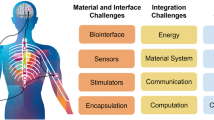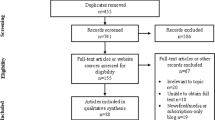Abstract
A digital twin (DT) of the human body is a virtual representation of an individual’s physiological state, created using real-time data from sensors and medical devices, with the purpose of simulating, predicting and optimizing health outcomes through advanced analysis and modelling. Human body DTs have the potential to revolutionize healthcare and wellness, but their responsible and effective implementation requires consideration of multiple intertwined engineering aspects. This Perspective presents an overview of the status and prospects of the human body DT and proposes a five-level roadmap to guide its development, from the sensing components, in the form of wearable devices, to the data collection, analysis and decision-making systems. The support, security, cost and ethical considerations that must be addressed are also highlighted. Finally, we provide a framework for the development and a perspective on the future of the human body DT, to aid interdisciplinary research and solutions for this evolving field.
Key points
-
Human body digital twins (DTs) can be modelled following a five-level approach.
-
Wearable sensor technologies and algorithms are needed to capture human data and build the DTs.
-
Support, security, cost and ethics must be considered to ensure responsible and effective implementation of the human body DTs.
-
Limitations and prospects of human body DTs are related to the need for efficient computational architectures, and their effective integration in clinical settings for personalized diagnostics and treatments.
This is a preview of subscription content, access via your institution
Access options
Subscribe to this journal
Receive 12 digital issues and online access to articles
$119.00 per year
only $9.92 per issue
Buy this article
- Purchase on Springer Link
- Instant access to full article PDF
Prices may be subject to local taxes which are calculated during checkout



Similar content being viewed by others
References
Sotirakis, C. et al. Identification of motor progression in Parkinson’s disease using wearable sensors and machine learning. npj Parkinson’s Dis. 9, 142 (2023).
Hampel, H. et al. Designing the next-generation clinical care pathway for Alzheimer’s disease. Nat. Aging 2, 692–703 (2022).
Chao, H. et al. Deep learning predicts cardiovascular disease risks from lung cancer screening low dose computed tomography. Nat. Commun. 12, 2963 (2021).
Radhakrishnan, A. et al. Cross-modal autoencoder framework learns holistic representations of cardiovascular state. Nat. Commun. 14, 2436 (2023).
Sun, Z. et al. A next-generation tumor-targeting IL-2 preferentially promotes tumor-infiltrating CD8+ T-cell response and effective tumor control. Nat. Commun. 10, 3874 (2019).
He, J. et al. Tumor targeting strategies of smart fluorescent nanoparticles and their applications in cancer diagnosis and treatment. Adv. Mater. 31, 1902409 (2019).
Taylor, J. P., Brown, R. H. & Cleveland, D. W. Decoding ALS: from genes to mechanism. Nature 539, 197–206 (2016).
Holgate, S. T. et al. Asthma. Nat. Rev. Dis. Primers 1, 15025 (2015).
Qian, W. et al. Digital twin driven production progress prediction for discrete manufacturing workshop. Robot. Comput. Integr. Manuf. 80, 102456 (2023).
Kušić, K. et al. A digital twin in transportation: real-time synergy of traffic data streams and simulation for virtualizing motorway dynamics. Adv. Eng. Inform. 55, 101858 (2023).
Elayan, H., Aloqaily, M. & Guizani, M. Digital twin for intelligent context-aware IoT healthcare systems. IEEE Internet Things J. 8, 16749–16757 (2021). This work outlines the implication of DT applications in digital healthcare within an Internet of Things context.
Acosta, J. N., Falcone, G. J., Rajpurkar, P. & Topol, E. J. Multimodal biomedical AI. Nat. Med. 28, 1773–1784 (2022). This review discusses the key applications, opportunities, modelling and privacy challenges that need to be overcome for realizing the full potential of multimodal artificial intelligence in health.
Coorey, G. et al. The health digital twin to tackle cardiovascular disease — a review of an emerging interdisciplinary field. npj Digital Med 5, 126 (2022). This review describes DT technologies for the development and application of cyberphysical systems as precision medicine tools in the management of cardiovascular diseases.
Wang, Y., Yang, X., Zhang, X., Wang, Y. & Pei, W. Implantable intracortical microelectrodes: reviewing the present with a focus on the future. Microsyst. Nanoeng. 9, 7 (2023).
Gao, F. et al. Wearable and flexible electrochemical sensors for sweat analysis: a review. Microsyst. Nanoeng. 9, 1 (2023).
Ramesh, A., Dhariwal, P., Nichol, A., Chu, C. & Chen, M. Hierarchical text-conditional image generation with CLIP latents. Preprint at https://doi.org/10.48550/arXiv.2204.06125 (2022).
Ouyang, L. et al. Training language models to follow instructions with human feedback. Adv. Neural Inf. Process. Syst. 35, 27730–27744 (2022).
Viola, F. et al. GPU accelerated digital twins of the human heart open new routes for cardiovascular research. Sci. Rep. 13, 8230 (2023).
Ghose, S. et al. 3D reconstruction of skin and spatial mapping of immune cell density, vascular distance and effects of sun exposure and aging. Commun. Biol. 6, 718 (2023).
Radford, A. et al. Learning transferable visual models from natural language supervision. Proc. Mach. Learn. Res. 139, 8748–8763 (2021). This work outlines the importance of contrastive language–image pretraining learning approaches imported from computer vision and natural language processing to other fields, including the development of human body DTs which are of interest in this Perspective.
Jacobsen, M. et al. Wearable based monitoring and self-supervised contrastive learning detect clinical complications during treatment of hematologic malignancies. npj Digital Med. 6, 105 (2023).
Jiang, Y. et al. Predicting peritoneal recurrence and disease-free survival from CT images in gastric cancer with multitask deep learning: a retrospective study. Lancet Digital Health 4, e340–e350 (2022).
Erion, G. et al. A cost-aware framework for the development of AI models for healthcare applications. Nat. Biomed. Eng. 6, 1384–1398 (2022).
Cen, S. et al. Toward precision medicine using a ‘digital twin’ approach: modeling the onset of disease-specific brain atrophy in individuals with multiple sclerosis. Sci. Rep. 13, 16279 (2023).
Lin, T. Y. et al. Assessing overdiagnosis of fecal immunological test screening for colorectal cancer with a digital twin approach. npj Digital Med. 6, 24 (2023).
Parikh, S. et al. Food-seeking behavior is triggered by skin ultraviolet exposure in males. Nat. Metab. 4, 883–900 (2022).
Yoo, W. et al. High-fat diet–induced colonocyte dysfunction escalates microbiota-derived trimethylamine N-oxide. Science 373, 813–818 (2021).
Lee, C. R., Chen, A. & Tye, K. M. The neural circuitry of social homeostasis: consequences of acute versus chronic social isolation. Cell 184, 1500–1516 (2021).
Yimyai, T. et al. Self‐healing photochromic elastomer composites for wearable UV‐sensors. Adv. Funct. Mater. 33, 2213717 (2023).
Kim, J. et al. A conformable sensory face mask for decoding biological and environmental signals. Nat. Electron. 5, 794–807 (2022).
Shad, R., Cunningham, J. P., Ashley, E. A., Langlotz, C. P. & Hiesinger, W. Designing clinically translatable artificial intelligence systems for high-dimensional medical imaging. Nat. Mach. Intell. 3, 929–935 (2021).
Ghassemi, M., Oakden-Rayner, L. & Beam, A. L. The false hope of current approaches to explainable artificial intelligence in health care. Lancet Digital Health 3, e745–e750 (2021).
Wei, J. et al. Emergent abilities of large language models. OpenReview https://openreview.net/pdf?id=yzkSU5zdwD (2022).
Lecun, Y. A path towards autonomous machine intelligence. OpenReview https://openreview.net/pdf?id=BZ5a1r-kVsf (2022).
Stiglic, G. et al. Interpretability of machine learning‐based prediction models in healthcare. WIREs Data Min. Knowl. Discov. 10, e1379 (2020).
Prosperi, M. et al. Causal inference and counterfactual prediction in machine learning for actionable healthcare. Nat. Mach. Intell. 2, 369–375 (2020).
Fuller, D. et al. Reliability and validity of commercially available wearable devices for measuring steps, energy expenditure, and heart rate: systematic review. JMIR Mhealth Uhealth 8, e18694 (2020).
Yang, B. et al. Wearable chem-biosensing devices: from basic research to commercial market. Lab. Chip 21, 4285–4310 (2021).
Zhang, X. et al. High-performance multimodal smart textile for artificial sensation and health monitoring. Nano Energy 103, 107778 (2022).
Kireev, D. et al. Continuous cuffless monitoring of arterial blood pressure via graphene bioimpedance tattoos. Nat. Nanotechnol. 17, 864–870 (2022).
Hartel, M. C., Lee, D., Weiss, P. S., Wang, J. & Kim, J. Resettable sweat-powered wearable electrochromic biosensor. Biosens. Bioelectron. 215, 114565 (2022).
Wang, C. et al. Bioadhesive ultrasound for long-term continuous imaging of diverse organs. Science 377, 517–523 (2022).
Tschaikner, M. et al. Development of a single-site device for conjoined glucose sensing and insulin delivery in type-1 diabetes patients. IEEE Trans. Biomed. Eng. 67, 312–322 (2020).
Davies, H. J., Williams, I., Peters, N. S. & Mandic, D. P. In-ear SpO2: a tool for wearable, unobtrusive monitoring of core blood oxygen saturation. Sensors 20, 4879 (2020).
Goverdovsky, V. et al. Hearables: multimodal physiological in-ear sensing. Sci. Rep. 7, 6948 (2017).
Goverdovsky, V., Looney, D., Kidmose, P. & Mandic, D. P. In-ear EEG from viscoelastic generic earpieces: robust and unobtrusive 24/7 monitoring. IEEE Sens. J. 16, 271–277 (2016).
von Rosenberg, W. et al. Hearables: feasibility of recording cardiac rhythms from head and in-ear locations. R. Soc. Open. Sci. 4, 171214 (2017).
Occhipinti, E., Davies, H. J., Hammour, G. & Mandic, D. P. Hearables: artefact removal in Ear-EEG for continuous 24/7 monitoring. In 2022 International Joint Conference on Neural Networks (IJCNN), https://doi.org/10.1109/ijcnn55064.2022.9892675 (2022).
Schuman, C. D. et al. Opportunities for neuromorphic computing algorithms and applications. Nat. Comput. Sci. 2, 10–19 (2022).
Lanza, M. et al. Memristive technologies for data storage, computation, encryption, and radio-frequency communication. Science 376, 6597 (2022).
Meng, Y. & Zhu, J. Low energy consumption fiber-type memristor array with integrated sensing-memory. Nanoscale Adv. 4, 1098–1104 (2022).
Zhang, H. et al. Recent progress of fiber-based transistors: materials, structures and applications. Front. Optoelectron. 15, 2 (2022).
Wang, T. et al. Reconfigurable neuromorphic memristor network for ultralow-power smart textile electronics. Nat. Commun. 13, 7432 (2022).
Roldan, J. B. et al. Spiking neural networks based on two-dimensional materials. npj 2D Mater. Appl. 6, 63 (2022).
Sahal, R., Alsamhi, S. H. & Brown, K. N. Personal digital twin: a close look into the present and a step towards the future of personalised healthcare industry. Sensors 22, 5918 (2022).
Prattis, I. et al. Graphene for biosensing applications in point-of-care testing. Trends Biotechnol. 39, 1065–1077 (2021).
Li, S. et al. Humidity-sensitive chemoelectric flexible sensors based on metal–air redox reaction for health management. Nat. Commun. 13, 5416 (2022).
Acknowledgements
L.G.O., C.T. and W.Y. acknowledge funding from the UK Engineering and Physical Sciences Research Council (grants EP/W024284/1, EP/P027628/1, EP/K03099X/1, EP/L016087/1 and EP/L015889/1). E.O. was supported by the UKRI Centre for Doctoral Training in AI for Healthcare (grant EP/S023283/1). S.G. and Y.D. acknowledge funding from the National Natural Science Foundation of China (grants 62171014 and 61803017).
Author information
Authors and Affiliations
Contributions
All authors researched data for the article, contributed substantially to discussion of the content and wrote the article. L.G.O. reviewed and edited the manuscript before submission.
Corresponding authors
Ethics declarations
Competing interests
The authors declare no competing interests.
Peer review
Peer review information
Nature Reviews Electrical Engineering thanks Ali Ahmad Malik and Issam El Naqa for their contribution to the peer review of this work.
Additional information
Publisher’s note Springer Nature remains neutral with regard to jurisdictional claims in published maps and institutional affiliations.
Rights and permissions
Springer Nature or its licensor (e.g. a society or other partner) holds exclusive rights to this article under a publishing agreement with the author(s) or other rightsholder(s); author self-archiving of the accepted manuscript version of this article is solely governed by the terms of such publishing agreement and applicable law.
About this article
Cite this article
Tang, C., Yi, W., Occhipinti, E. et al. A roadmap for the development of human body digital twins. Nat Rev Electr Eng 1, 199–207 (2024). https://doi.org/10.1038/s44287-024-00025-w
Accepted:
Published:
Issue Date:
DOI: https://doi.org/10.1038/s44287-024-00025-w



